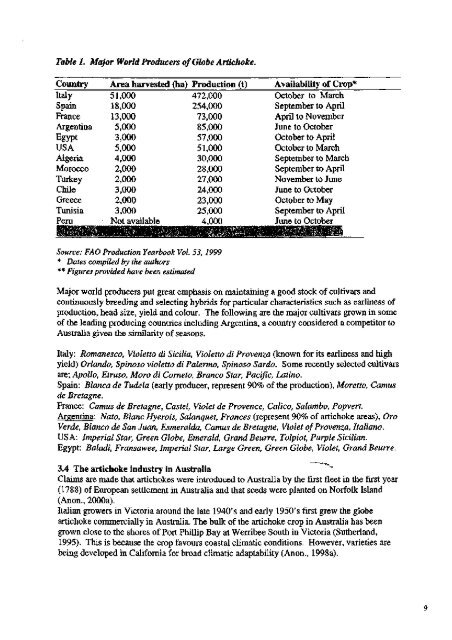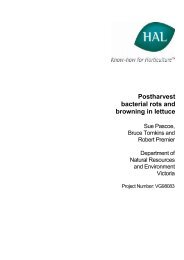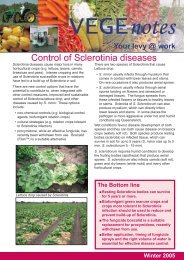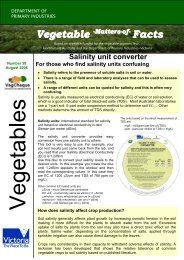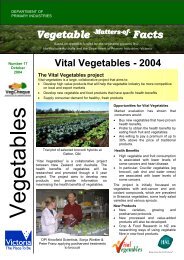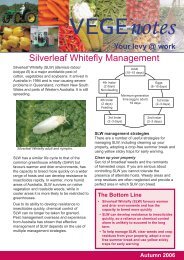Table 1. Major World Producers of Globe Artichoke.Country Area harvested (ha) Production (t) Availability of Crop*Italy 51,000 472,000 Oc<strong>to</strong>ber <strong>to</strong> MarchSpain 18,000 254,000 September <strong>to</strong> AprilFrance 13,000 73,000 April <strong>to</strong> NovemberArgentina 5,000 85,000 June <strong>to</strong> Oc<strong>to</strong>berEgypt 3,000 57,000 Oc<strong>to</strong>ber <strong>to</strong> AprilUSA 5,000 51,000 Oc<strong>to</strong>ber <strong>to</strong> MarchAlgeria 4,000 30,000 September <strong>to</strong> MarchMorocco 2,000 28,000 September <strong>to</strong> AprilTurkey 2,000 27,000 November <strong>to</strong> JuneChile 3,000 24,000 June <strong>to</strong> Oc<strong>to</strong>berGreece 2,000 23,000 Oc<strong>to</strong>ber <strong>to</strong> MayTunisia 3,000 25,000 September <strong>to</strong> AprilPeru Not available 4,000 June <strong>to</strong> Oc<strong>to</strong>ber\ustnilu' 300 1 500 M.i\ <strong>to</strong> ScpLunbLrSource: FAO Production Yearbook Vol. 53, 1999* Dates compiled by the authors** Figures provided have been estimatedMajor world producers put great emphasis on maintaining a good s<strong>to</strong>ck of cultivars <strong>and</strong>continuously breeding <strong>and</strong> selecting hybrids for particular characteristics such as earliness ofproduction, head size, yield <strong>and</strong> colour. The following are the major cultivars grown in someof the leading producing countries including Argentina, a country considered a competi<strong>to</strong>r <strong>to</strong>Australia given the similarity of seasons.Italy: Romanesco, Violet<strong>to</strong> di Sicilia, Violet<strong>to</strong> di Provenza (known for its earliness <strong>and</strong> highyield) Orl<strong>and</strong>o, Spinoso violet<strong>to</strong> di Palermo, Spinoso Sardo. Some recently selected cultivarsare; Apollo^ Etruso, Moro di Corne<strong>to</strong>, Branco Star, Pacific, Latino.Spain: Blanca de Tudela (early producer, represent 90% of the production), Moret<strong>to</strong>, Camusde Bretagne.France: Camus de Bretagne, Castel, Violet de Provence, Calico, Salambo, Popvert.Argentina: Na<strong>to</strong>, Blanc Hyerois, Salanquet, Frances (represent 90% of artichoke areas), OroVerde, Blanco de San Juan, Esmeralda, Camus de Bretagne, Violet of Provenza, Italiano.USA: Imperial Star, Green Globe, Emerald, Gr<strong>and</strong> Beurre, Tolpiot, Purple Sicilian.Egypt: Baladi, Fransawee, Imperial Star, Large Green, Green Globe, Violet, Gr<strong>and</strong> Beurre.3.4 The artichoke industry in Australia """Claims are made that artichokes were introduced <strong>to</strong> Australia by the first fleet in the first year(1788) of European settlement in Australia <strong>and</strong> that seeds were planted on Norfolk Isl<strong>and</strong>(Anon., 2000a).Italian growers in Vic<strong>to</strong>ria around the late 1940's <strong>and</strong> early 1950's first grew the globeartichoke commercially in Australia. The bulk of the artichoke crop in Australia has beengrown close <strong>to</strong> the shores of Port Phillip Bay at Werribee South in Vic<strong>to</strong>ria (Sutherl<strong>and</strong>,1995). This is because the crop favours coastal climatic conditions. However, varieties arebeing developed in California for broad climatic adaptability (Anon., 1998a).9
Dr.S.C.Tan <strong>and</strong> Mr H.Hoffmann in Western Australia are also looking in<strong>to</strong> suitable U.S.cultivars for that state (Horticulture Australia Limited, project No.VG97042). In Italyresearchers have found remarkable differences in the biochemical constituents betweendifferent cultivars (Venere et al., 2000). According <strong>to</strong> this research this variability could be auseful indica<strong>to</strong>r of the suitability of various cultivars <strong>to</strong> specific uses (eg. fresh, frozen,preserved in oil etc.). Unlike in overseas countries where a broad gene pool of cultivarsexists, in Australia there is a serious shortage of reliable cultivar material. Some of thepopular cultivars currently used by many growers, such as Green Globe <strong>and</strong> Purple Globe areof unknown origin. The majority of growers appreciate the practicality of using seededcultivars that are currently available. However, few are currently experimenting with suchcultivars <strong>to</strong> test their general performance <strong>and</strong> reliability.Various recent publications refer <strong>to</strong> Australian artichoke production as being steady at 500<strong>to</strong>nnes. However, based on the information gathered in our investigation, the artichokeproduction figure is more like 1300 <strong>to</strong>nnes (see section 5.1.2). Despite this small productioncompared <strong>to</strong> some overseas producers (Table 1), Australia manages <strong>to</strong> <strong>export</strong> small volumesof fresh artichokes in an ad-hoc fashion mainly <strong>to</strong> hospitality trades in the Asia/Pacific region.Trade figures, show that between 1994/95 <strong>and</strong> 1999/2000, the volume of globe artichokes(fresh or chilled) <strong>export</strong>s ranged from a low of 2.5 <strong>to</strong>nnes ($A5580 per <strong>to</strong>nne f.o.b.) in1995/96 <strong>to</strong> a high of 80 <strong>to</strong>nnes ($A3342 per <strong>to</strong>nne f.o.b.) in 1999/2000 (Anon., 2001a).Statistical Information Service). The statistics also show that Australia's four major <strong>export</strong>smarkets in 1999 were Taiwan, New Caledonia, Singapore <strong>and</strong> Brunei. Other markets include;Japan, Singapore, China {Hong Kong), Korea, Malaysia <strong>and</strong> Germany.3.5 Uses <strong>and</strong> health benefitsVarious parts of the globe artichoke can be used in different ways <strong>and</strong> for different purposes.The principal edible portion of the immature flower bud we call the artichoke's heart iscomposed of the fleshy bracts <strong>and</strong> the receptacle <strong>to</strong> which the bracts are attached. This part isconsumed in a number of ways, such as steamed, boiled, stuffed <strong>and</strong> then baked, marinated<strong>and</strong> battered <strong>and</strong> then fried etc. Another part is the artichoke stalk which when peeledexposes its core, another edible portion of the plant that has a similar texture <strong>and</strong> flavour <strong>to</strong>the heart. A favourite Italian way of eating artichoke is "in pinzimonio" which involvesdipping the fleshy parts of the bracts one by one in<strong>to</strong> a vinigraite dressing mixture as above<strong>and</strong> scrapping it off between the teeth. Besides fresh, various forms of processed artichokeare available on the markets such as preserved whole hearts in brine, frozen <strong>and</strong> antipas<strong>to</strong>(appetiser) products, purees (Plate 2).Globe artichoke is a versatile vegetable, renown for its nutritional value <strong>and</strong> excellent health^benefits because of its high fibre, vitamin <strong>and</strong> mineral content, especially iron (Appendix 1).This is in addition <strong>to</strong> its high content of phy<strong>to</strong>chemical or nutraceutical substances withmedicinal functions such as caffeoylquinic acid <strong>and</strong> cynarin. It is well documented thatextracts of globe artichoke leaves are known for their ability <strong>to</strong> de<strong>to</strong>xify the liver <strong>and</strong><strong>stimulate</strong> bile secretion (Wegener <strong>and</strong> Fintelmann, 1999) <strong>and</strong> <strong>to</strong> inhibit cholesterolbiosynthesis (Gebhardt, 1998). In Argentina, growers can generate additional income fromselling artichoke leaves (1.5-3.0 kg per plant at approximately $A1.00 per kg) <strong>to</strong> thepharmaceuticals industry (Garcia et al.2000). Cardinali et al., 2000 have shown that theleaves <strong>and</strong> external bud bracts (which are discarded as waste during processing) representabout 70% of the <strong>to</strong>tal biomass <strong>and</strong> could be utilised <strong>to</strong> extract important phy<strong>to</strong>chemicalcompounds. Almela et al., 2000 found that artichoke waste is a valuable material that couldbe used for animal fodder due <strong>to</strong> its Mgh <strong>to</strong>tal protein content, which is comparable with other10


